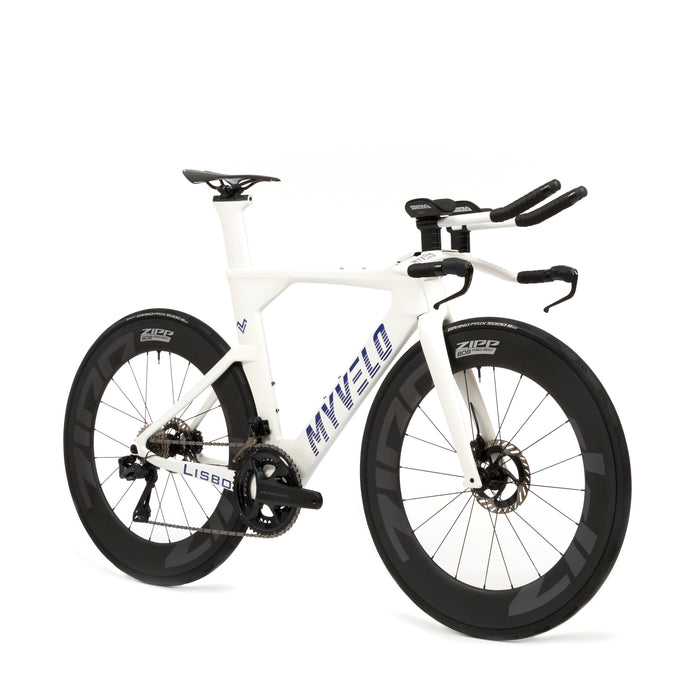
Lisboa triathlon bike
incl. FREE shipping & free returns

In cycling, drafting refers to riding in the slipstream of one or more riders ahead. The rider behind takes advantage of the reduced air resistance to maintain the same speed with less energy expenditure. The term derives from the English word " to draft " (to pull).
When cycling, air resistance is one of the biggest energy consumers—especially at speeds above 30 km/h. Drafting significantly reduces this resistance:
A rider in the direct slipstream can save up to 30–40% energy .
The closer the drivers are to each other, the stronger the effect.
In larger groups, such as a peloton , all riders inside benefit from collective wind protection.
Drafting is a central tactical element in road cycling:
Riders take turns leading to distribute the workload evenly (e.g. in breakaway groups).
In sprint trains, a sprinter is protected until shortly before the finish by targeted drafting.
In the peloton , drafting helps save energy over long distances.
Distance : The distance between the wheels is often only a few centimeters. This requires utmost concentration and bike control.
Positioning : A good position in the slipstream is crucial, especially in windy conditions, on climbs or before sprints to the finish.
Wind direction : In crosswinds, riders form so-called echelons or “wind squadrons” to protect themselves optimally.
Drafting is prohibited in many triathlon disciplines and in individual time trials. To ensure equal opportunities, minimum distances (e.g., 10–12 meters) are maintained between athletes. Violations are punished with time penalties.
Drafting can also noticeably improve endurance performance in amateur sports:
Group rides allow for longer distances with less fatigue.
Cycle touring (RTFs) and amateur races offer ideal opportunities to practice drafting effectively.
Safety and communication are paramount – anticipatory driving is essential.
Advantages of drafting:
✔️ Less energy consumption
✔️ Higher average speed
✔️ Tactical flexibility
✔️ Teamwork and cooperation
Risks:
⚠️ Increased risk of falls due to inattentive driving
⚠️ Dependence on the driving style of the person in front
⚠️ Limited forward visibility

Entdecke den MYVELO
Entdecke Dein Traum E-Bike im MYVELO Onlineshop. Direkt vom Hersteller Dein Fahrrad aussuchen.

Dein Traumrad
MYVELO hat bereits 2 Standorte: Oberkirch & Geretsried. Komm in unsere Flagship Stores und probiere Dein Traum Bike aus. Lass Dich von uns zu Deinen Anforderungen beraten.

Leasen statt kaufen
Spare mit Leasing! Finanziere Dein Traum E-Bike ganz einfach über Deinen Arbeitgeber. MYVELO unterstützt Dich im Leasing-Prozess bei Deinen Fragen.

Wer sich den Traum vom hochwertigen E-Bike erfüllen möchte, steht oft vor einer großen Investition. Doch immer mehr Menschen entdecken eine clevere Alternative zum Kauf: das Fahrrad privat leasen. Was bisher vor allem im Jobrad-Modell über Arbeitgeber bekannt war, funktioniert heute auch für Privatpersonen – flexibel, günstig und steuerlich oft vorteilhaft.

Wer mit dem Fahrrad oder E-Bike unterwegs ist, weiß: Die richtige Schalttechnik macht den Unterschied zwischen einem flüssigen, energiesparenden Fahrstil und unnötiger Anstrengung. Doch viele Radfahrerinnen und Radfahrer nutzen ihre Gangschaltung nicht optimal – sei es aus Unsicherheit oder Gewohnheit. In diesem Artikel erfährst Du, wie man richtig schaltet, worauf man bei E-Bikes mit Kettenschaltung oder Nabenschaltung achten sollte und welche Fehler man vermeiden kann.

Das Hollandrad ist längst mehr als nur ein Klassiker aus den Grachtenstädten der Niederlande – es ist ein Sinnbild für entspanntes Radfahren, Komfort und zeitloses Design. In deutschen Städten erlebt das Hollandrad derzeit ein echtes Comeback, nicht zuletzt, weil es den urbanen Lifestyle perfekt widerspiegelt. Doch worin unterscheidet sich ein Hollandrad eigentlich von einem Citybike – und welche Rolle spielen moderne E-Bike-Versionen?